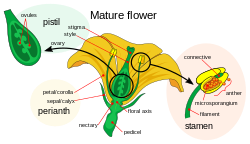Perianth
The collective term for the sepals and petals, or either of them if one is absent. the outer part of a flower, consisting of the calyx and corolla
The perianth (perigonium, perigon or perigone in monocots) is the non-reproductive part of the flower. It forms an envelope surrounding the sexual organs. [1]

It includes the calyx (sepals) and the corolla (petals) when called a perigone.
The term perianth is got from the Greek περί (peri, "around") and άνθος (anthos, "flower"). Perigonium is got from περί (peri) and γόνος (gonos, "seed, sex organs").
In the mosses and liverworts (Marchantiophyta), the perianth is the sterile tubelike tissue that surrounds the female reproductive structure (or developing sporophyte).
References change
- ↑ Beentje H. & Williamson J. 2010. The Kew Plant Glossary: an illustrated dictionary of plant terms. Royal Botanic Gardens, Kew: Kew Publishing.